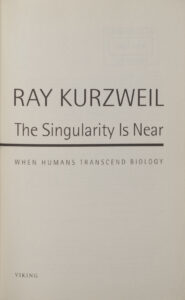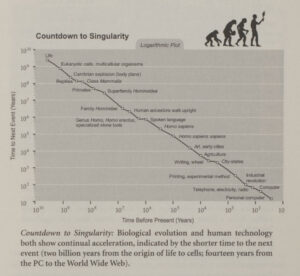Inventor and futurist Ray Kurzweil (MIT class of 1970) defines the Singularity as “a future period during which the pace of technological change will be so rapid, its impact so deep, that human life will be irreversibly transformed.” This prediction is based on the idea that information technology develops exponentially, and that this development occurs at a predictable rate, resulting in accelerating returns. Given such an exponential rate of growth, Kurzweil, in considering our future, argues that
we won’t experience one hundred years of technological advance in the twenty-first century; we will witness on the order of twenty thousand years of progress … (when measured by today’s rate of progress), or about one thousand times greater than what was achieved in the twentieth century.
Kurzweil gives dates for a number of his predictions. For example, he predicts that reverse engineering of the human brain will be achieved by the year 2029. This event will help lead us into the Singularity itself, which Kurzweil predicts will occur in 2045.
 As with any technological development, there will be benefits and risks. The Singularity may allow us to improve our medical knowledge to the point where we are able to live indefinitely, using nanobots to repair our bodies as they break down. But at the same time, it could lead to artificial intelligence that is unfriendly to humankind. It’s very difficult to predict how people will apply highly advanced technologies in the future.
As with any technological development, there will be benefits and risks. The Singularity may allow us to improve our medical knowledge to the point where we are able to live indefinitely, using nanobots to repair our bodies as they break down. But at the same time, it could lead to artificial intelligence that is unfriendly to humankind. It’s very difficult to predict how people will apply highly advanced technologies in the future.
Whether or not you agree with all of Kurzweil’s claims, it’s impossible to refute the steady increase in the acceleration of technological progress over the past hundred years. Nor can anyone deny that the rate of progress is likely to continue increasing. Great advances lay in our future. Let’s hope we’re prepared, mentally and ethically, to deal with them.


